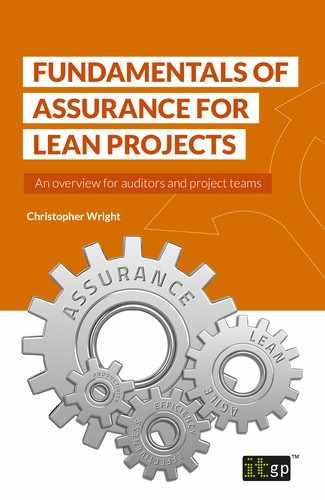PREFACE
Lean and agile. Phrases not usually used to describe auditors and other risk management specialists! But increasingly we are asked to provide advice and assurance on agile and lean projects. As their names imply, these projects require fast, low cost and low impact reviews – whilst still providing stakeholders with useful assurance and advice. Since I wrote my first book on agile audit (Agile Audit and Governance), an increasing number of clients and contacts have been asking me about lean. Although this approach is still rare for pure IT projects where Agile Scrum still dominates, it is becoming very common as the basis for business based change and transformation projects, and we are also seeing a spread of ‘lean start-ups’. There are new risks associated with these projects including:
• Is the project cost effective?
• Will it achieve its objectives?
• What are the impacts of the project on other parts of the business?
• How about project management, governance and compliance?
Management are keen to ensure that governance and compliance are in place, but without proper guidance the assurer could provide inappropriate advice – leading to delays and costs. The most common reason for this is a lack of understanding by the reviewer. As a result, they seek to apply tools and techniques they are comfortable with – rather than providing valuable input. This can be wasteful of time and effort which is not in line with the lean philosophy. Also, conclusions and recommendations can be flawed. Hence the need for this book.
I remember in the mid 1970s my father needed to buy a specialised four wheel drive light truck. I went with him on some of the fact finding. It came down to two potential truck makers:
Supplier 1 – UK based and very local to us, had many vehicles in stock but none to meet the requirements. They could produce one in six months but it would still then need to go to a coachbuilder for further refinements to meet the specification. We visited the factory production line and saw demotivated staff working on trivial tasks. We knew that this producer had problems with quality.
Supplier 2 – Japanese based, could deliver to the full specification in three months, even if it required some of the modifications to be made on the ship as the vehicle was transported to the UK. The supplier had a reputation for high quality and price was negotiable.
This was probably the first time I had encountered the lean phenomena and may illustrate one of the reasons for the demise of the UK owned mass vehicle producers. By the way, he had to choose the local option – which proved to be the wrong choice!
My very first audit in internal audit, over 35 years ago, was to help with a management/operational review of the leisure and recreation facilities at Leicester City Council. Instead of the normal focus on cash controls, etc. we looked at the processes for room booking, cash receipting, staff planning and management. We were concerned to ensure that these processes had minimal waste and were fit for purpose. They needed to provide good value for money, based on what would become known as the ‘3 Es’:
Economy – were the required resources provided at an appropriate cost?
Efficiency – were these applied in a cost effective way to produce useful outputs with minimal costs?
Effectiveness – were the theatres and centres doing the right things? Were their objectives in line with what customers actually needed and wanted (e.g. opening times for swimming pools, etc.)?
Today, if we used similar techniques it would be classed as a ‘lean’ review, as it aimed to improve quality and customer satisfaction whilst reducing costs. Over the years I have conducted a number of these reviews including hospital pharmacy and pathology labs, IT service provision, local authority planning, housing and property repairs. I have also provided assurance for agile and lean projects, providing turnaround solutions where possible, and recommending the abandonment of the project where final costs would not have provided adequate payback from the benefits likely to be achieved.
I have written this book to share this knowledge and experience with you, the reader. My aim is to smash through some of the jargon and mystique that surrounds lean and provide you with some guidance and tips on how to perform audits, or assurance reviews, for these projects. When undertaking an assurance review of lean projects, many of the governance and audit principles for other projects still need to be considered (control of time, costs, quality and production of stated business benefits).
Finally, I believe that when conducting audits we should ‘practise what we preach’ and so should use lean tools and techniques in the actual conduct of our reviews – I have included a chapter on this at the end of the book. As with all books in the ‘Fundamentals’ series, it provides an introduction to the subject and includes references for those who would like to further investigate specific areas.
